�
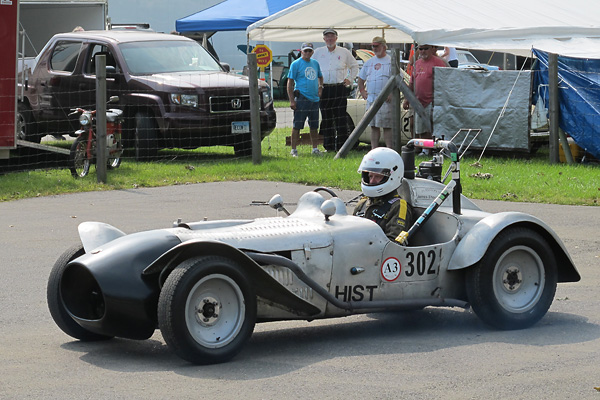
�
The Duncan Black / James Shoup Miller 1949 Lester MG
� � Owners: Doug Schirripa & Tom McCormack� City: Troy, New York
� Model: 1949 Lester MG
� Engine: 1958 MG 1.5L
� Race prepared by: Schirripa & McCormack�
�
Harry Lester and "The Monkey Stable"
��
Between 1949 and 1955, Harry Lester of Hertfordshire built about ten racecars based on MG drivetrain�
and chassis components but featuring stiffer and lower swept frames made from round tubing, streamlined�
bodywork, and larger engine displacements. Harry Lester was already a well established MG specialist�
and racer. Before World War II he had modified and raced an MG PB (serial number PB1237, registration�
number GUR 963) and after the war he resumed racing with an MG L-type Magna (registration number HRO 33)�
in 1948 and an MG TA (serial number TA2460, registration number KJH 114) in 1949. Throughout the era he�
also modified and race-prepared an unknown number of MG sports cars for his shop's customers, but Harry�
Lester's tube-chassis racers were his most distinctive and successful product.�
�
The earliest racing appearance of a tube-chassis Lester MG racecar that we've been able to document�
was at Blandford on 27 August 1949. Harry Lester's entry that day was identified in race reports as a�
"Lester T51 MG" with registration number KUR 4. He finished in third place. Again with KUR 4, Harry�
placed third in a Members Handicap Race at Goodwood on 17 June 1950. Lester returned to Goodwood�
on 12 August, and this time drove KUR 4 to victory. During the 1951 season, race reports�
mentioned several different Lester MG racecars including KUR 4, Reg Croysdill's KRO 548 and Jim Mayers'�
NNK 526. Harry Lester and Pat Griffith both entered MG 6850 on occasion. Late in the season, KUR 4 was�
sold and shipped to North America where it was entered in at least two races before the end of 1951.�
�
�
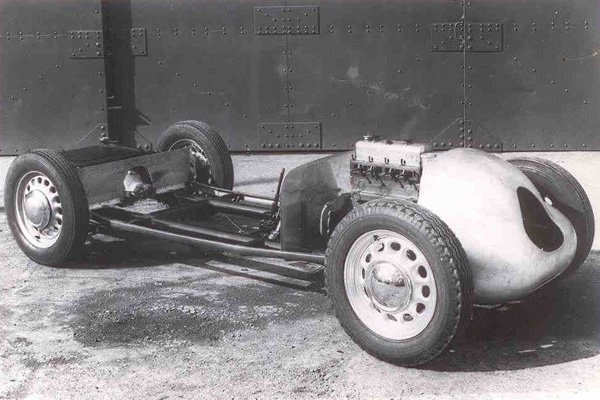
�
KUR 4 and subsequent Lester MG racecars feature lightweight, low-slung, round-tube frames.
�
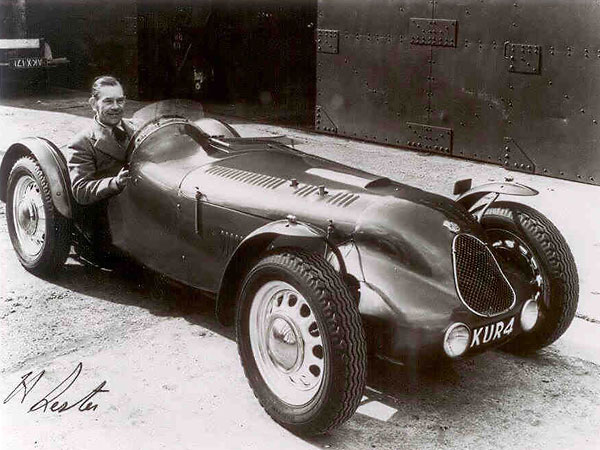
�
Harry Lester shows off his newly completed racecar: KUR 4.
�
�
Through this period, a partnership developed between Harry Lester and wealthy racing enthusiast�
Jim C.C. Mayers. Together, they entered Lester MG racecars in a number of British National�
races and their success and reputations grew together. For the 1952 racing season Lester and Mayers�
planned a three-car racing team which they called "The Monkey Stable." �
Their first season was notably successful within the class they competed: 1.5L Sports Cars.�
�
Undoubtedly, The Monkey Stable's most memorable race was the heavily promoted, inaugural, BARC�
News of the World International Nine-Hour race at Goodwood. Running from 3pm until midnight,�
it was Britain's first after-dark endurance race. Many people remember this famous race as�
an eventful dual between Aston Martin, Jaguar and Ferrari works teams for the overall victory.�
However, The Monkey Stable managed an impressive sweep of the first three places in the under�
1.5L class! Co-drivers Jim Mayers and Mike Keen finished sixth overall in NNK 526,�
co-drivers Gerry Ruddock and Rodney F. Peacock in NPO 20 finished seventh overall, and�
co-drivers Les Leston and Tommy Line in MG 6850 finished eighth overall.�
(Pat Griffith was unable to drive for The Monkey Stable on that particular day because he had�
previously committed to Aston Martin. As it turned out, Griffith was co-driver with Peter Collins�
of the Aston Martin DB3S that won first place overall.)�
�
New cars would be required for Mayers and his team to stay truly competitive in 1953, but Harry Lester�
was unable to develop and produce a new chassis quickly enough. Instead, he prepared MG engines for�
three Kieft race cars, and on the side he also personally raced the latest Lester MG (HJB 790) on�
five occasions. Lester's races in HJB 790 gave him an opportunity to test some of his newest�
design ideas. The Monkey Stable team's 1953 results were disappointing in every respect, and at the�
end of the season Mayers sold the three cars. The Monkey Stable team then sat out 1954 while�
Harry Lester made plans for 1955.�
�
To suit a variety of races and classes, Lester envisioned two distinct M-series models: the Lester M-11�
would have Coventry Climax FWA 1098cc engines whereas the Lester M-15 would have MG 1.5L engines.�
Fiberglass spyder and coupe bodies were planned and there was talk of putting the design into serial�
production (following the lead of Turner Sports Cars, Ltd., and others.) Harry Lester built a prototype�
and the Monkey Stable shop built two additional M-series chassis. Probably no more than two M-series�
cars were ready for use during the 1955 season: an M-15 coupe (registration number 5 EME) was driven�
by Jim Mayers on one occasion and by Michael R.G. Llewellyn on seven occasions. An M-11 coupe may have�
been raced by John Shove, but we've had difficulty documenting the details.¹ �
�
The Monkey Stable team came to an abrupt end in September 1955 when Jim Mayers was killed while�
driving a Cooper-Climax at Dundrod in the Tourist Trophy Race. The team's assets, including at�
least one uncompleted M-series racecar, were sold off at that time. Harry Lester quit racing,�
quit building cars, and focused his attention on his garage business. At least a half dozen Lester�
race cars still exist today. Most, if not all, have been substantially modified. �
�
�

�
Harry Lester drove KUR 4 to a 3rd place finish in a National race at Blandford on 8 August 1949.
�
Starting in 1948 and continuing for about a decade, races were held on the 3.14 mile long perimeter
�
road around the Blandford Camp military base. The base is located in Dorset county, near Poole.
�
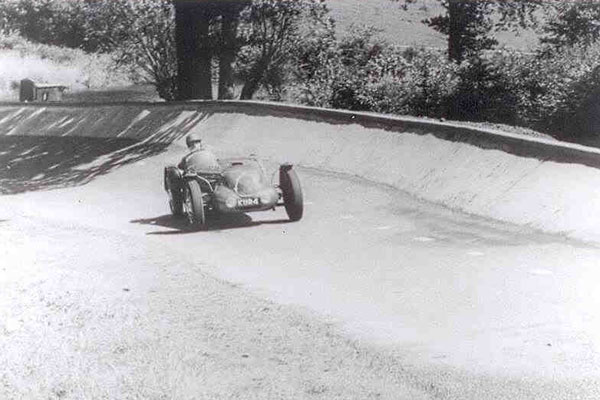
�
KUR 4 at the Great Auclum National Speed Hill Climb which was held from 1947 to 1974 on the grounds
�
of a private country home near Burghfield Common in Berkshire. In two respects it was the shortest
�
event in the RAC Hill Climb Championship: ~440 yards long and with both downhill and uphill sections.
�
Lester's Engines
� �
Enlarged engines were an important feature of the Lester MGs. Ordinary production MG "XPAG" engines of�
the TC and TD models have a 66.5mm cylinder bore and a 90mm stroke, which works out to a displacement of�
just 1250cc. Harry Lester boldly bored-out MG engine blocks, cutting so deeply that he was into their�
water jackets, and then he pressed in cylinder sleeves with an inside diameter of ~72mm to produce a �
displacement of ~1467cc. He completed these engines with Harry Weslake cylinder heads, special�
camshafts, and lightweight flywheels. As configured, static compression ratio was reportedly raised�
from 7.25:1 to ~10:1, and engine output was reportedly raised from 54.4hp at 5200rpm to just over�
100hp. Carefully balanced and tuned, Lester engines revved freely to over 6500rpm. �
�
With their enlarged engines, Lester MGs could be very competitive in Britain's "1.5L Sports" class.�
When Lester MGs raced in North America, their oversized engines bumped them up into the Sports Car�
Club of America's F Modified class. Most other MG specials raced in SCCA's G Modified class.�
�
 �
�
�
�
Duncan Black's Lester MG
��
In this article, we're featuring the best known and most successful Lester MG racecar: KUR 4.�
As mentioned above, this was the first purpose-built Lester MG racecar. After just a handful�
of races in England, it was the first Lester MG to be shipped to the United States. About half�
of Harry Lester's production would follow its journey. No other Lester MG would equal its results.�
�
After arriving in North America, KUR 4's first known appearance was to be in the hands of�
Perry Boswell in the Sagaponack Trophy Race at Bridgehampton on 9 June 1951. A clutch failure�
caused an early retirement. KUR 4's second known appearance was in the Queen Catherine Cup�
(under 1.5L) race at Watkins Glen on 14 September, 1951. On that occasion, David C. Viall drove�
KUR 4 to a second place finish!² David Viall also entered his Lester MG at the Second Annual�
Road Races at Palm Beach Shores Florida which were held December 8-9, 1951. In the Sunday afternoon�
two-hour endurance race Viall finished first in class and seventh overall of fourteen starters.�
�
KUR 4 made at least two appearances in New York State in 1953, while owned by Donald E. Millians�
of Baltimore Maryland. The first of those was an SCCA National under 1.5L Modified class race at�
Bridgehampton on Long Island, on May 23rd where Millians finished fifth of 31 starters. (Briggs�
Cunningham won, in an OSCA.) The second was at Watkins Glen on the September 18-19 weekend. At�
Watkins Glen, Millians loaned his Lester MG to a young driver named Duncan Black who drove it to�
a fifth place finish of 29 starters in the 1953 Queen Catherine Cup race. (George Moffett�
won, in an OSCA.) Sometime after this, we're told Duncan Black blew up the Lester's MG engine�
but made things right by purchasing the car. We have not been able to confirm this story; but�
it's clear that Duncan Black acquired the car.�
�
There have been at least four famous men named Duncan Black. Our young Duncan Black earned�
his reputation as a racecar driver. He won three SCCA National Championships with his�
Daimler SP250 ("Dart") between 1958 and 1963.�
He should not be confused with his father; Duncan Black Sr. invented the pistol-grip portable�
electric drill and co-founded the Black & Decker tool company.�
�
Duncan Black's Lester MG was powered by a race-tuned MG TC engine for the 1954 season, and�
programs from that year give its displacement as 1466cc. At that displacement, the car�
fit into SCCA's "F Modified" racing class. F Modified was a very tough class, dominated in�
many national races by new OSCA racecars. Still, Duncan Black had some memorable performances.�
In coverage of May 16th races at Cumberland Maryland, journalist Stuart Turner wrote:�
"Duncan Black, in one of the Lester MGs made it into the first corner well ahead of the�
pack. He maintained his lead for the first half dozen circuits with the little engine sounding�
fierce and showed no possibility of being headed. Then he was flagged off the course for�
riding with his safety belt unfastened. When he returned to the race the Uihline Special�
and the other Lester (driven by Don F. Marsh) had lapped him three times." �
�
�
Enjoying this article? www.BritishRaceCar.com is partially funded through generous support from readers like you!
�
To contribute to our operating budget, please click here and follow the instructions.
�
(Suggested contribution is twenty bucks per year. Feel free to give more!)�
�
On May 9 at Suffolk County A.F.B., Duncan Black finished fourth overall and second in class�
of 29 starters behind two E Modified Maserati racecars and Sherwood Johnston's OSCA.�
�
On June 13 at Westover A.F.B., Duncan Black finished first in class and fourth overall in�
"The Clipper" 65-mile race for Production cars under 3L and Modified cars under 2L.�
43 cars started that eighteen lap / 65 mile sprint race. Later in the day, Black entered the�
Steve Canyon Classic 47 lap / 175 mile unrestricted enduro. He finished third overall and�
first in class from a diverse field of 57 starters. Two Ferraris finished ahead of him.�
Behind him? Fourteen Jaguars, ten Austin-Healeys, six OSCAs, four Allards, and one�
Aston Martin (driven by Walt Hansgen). It was a tremendous performance!�
�
One week later, at the Equinox Hillclimb on June 20, Duncan Black again finished first in�
class and fourth overall with an elapsed time of 5:20.6. (The overall winner was Bill Lloyd,�
who covered the distance in just 5:04.0 with his Ferrari 2.7L.)�
�
At the Giant's Despair Hillclimb, Duncan Black and Don Marsh got a chance to race their�
Lester MGs together again. Black took first place over Marsh in Class F by barely more than�
half a second: 1:12.12 compared to 1:12.89! On the following day, on the narrow Brynfan Tyddyn�
road course, even stiffer competition arrived. In one report, journalist Ozzie Lyons summarized�
the results: "Duncan Black's Lester MG nibbled at the heels of Otto Linton's OSCA all during�
the feature race, only to run out of fuel on the last lap."�
�
At Watkins Glen in September, Black finished fifth overall of 35 starters in the 1954 Queen�
Catherine's Cup for cars under 1.5L.�
�
The 1954 season came to an exciting end for Duncan Black at Thompson Raceway in Connecticut�
on 14 October, where he valiantly chased Briggs Cunningham's OSCA but came up just a little�
short. Black's strong second place finish was comfortably ahead of Roy Thorpe in a Ferrari,�
Jackie Cooper in an Austin Healey 100S, and Fred Procter in a Maserati.�
�
In summary, Duncan Black and his Lester MG were very competitive through 1954. In terms�
of SCCA's National Championship points race, he had one disadvantage: some of his�
competitors were able to travel wider and participate in more races. Ultimately, he finished�
fourth in class, nationally! (First place went to Briggs Cunningham.)�
�
�
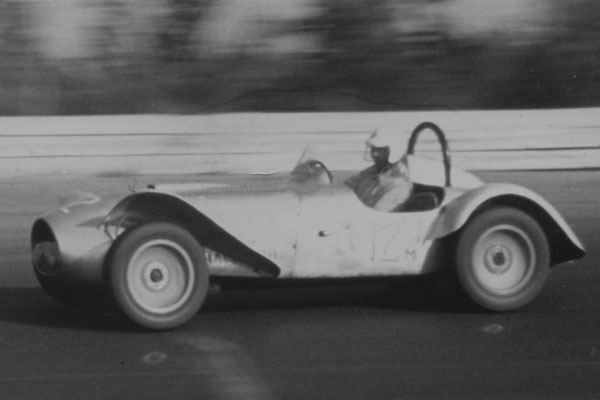
�
For 1955, Duncan Black replaced KUR4's original cycle-style fenders with flared fenders to meet new SCCA
�
class rules. This photo actually shows James Miller in one of his first appearances after purchasing KUR4.
�
This photo was taken by Maryel Miller at Marlboro Raceway in Maryland, probably in August 1957.
�
�
Between the 1954 and 1955 seasons, Duncan Black had the Lester MG's original cycle-style�
fenders replaced with newly custom fabricated aluminum fenders that flared back to the�
body. This was necessitated by a rule change: SCCA decided cycle fenders would no longer�
be permitted in its "modified" classes. The change increased the Lester MG's frontal area�
and it certainly didn't improve the car's coefficient of drag, so there's no question that�
the rule change made the Lester MG less competitive in an era when other cars�
were rapidly becoming more streamlined. Incidentally, some other body modifications would�
be made to Duncan Black's Lester MG later, but through 1955 he continued to use the car's�
original aluminum nose section, which featured two headlights faired-in below the radiator�
opening.�
�
In one way, May 15, 1955 was the high point for Lester MG racing in North America: four�
Lester MG racecars gathered to participate in the 1955 Cumberland National Sports Car Races.�
43,000 spectators crowded around an airport circuit, marked out with hay bales.�
The most successful Lester MG driver that day was Chuck H. Dietrich Jr., who won the G Modified class�
trophy. Three Lester MG racers - driven by Duncan Black, William A. Eager III, and�
R.D. Ryder - came for the F Modified trophy, but all three were outrun by Tippy Lipe in his �
Pooper (Porsche powered Cooper)�
and Phil Stewart in an OSCA. �
�
The inaugural race at Marlboro Motor Raceway in Upper Marlboro, Maryland was held on�
May 22, 1955. It was organized by the Lavender Hill Mob Racing Association and sanctioned�
by the SCCA. Duncan Black drove his Lester MG to a first place overall finish in the�
under 2-liter main feature race: "Duncan Black, in the Lester that never seemed to be�
going flat out, gobbled up the first..." Later in the day he entered another race for�
all modified classes, combined. "Here the Lester showed its teeth and before the pack�
had made the first turn onto the oval was well in front and stayed there without ever�
developing the characteristic scream that it has when being really pushed." (Both of�
these quotes are from a fascinating and well illustrated article in Sports Cars magazine.�
No specific author was credited.)�
�
Duncan Black raced KUR4 in the 1955 Mount Equinox hillclimb, finishing eleventh overall and�
third in class. He also entered KUR4 in the 1955 Giants Despair / Brynfan Tyddyn event on the�
July 21-23 weekend.�
�
�
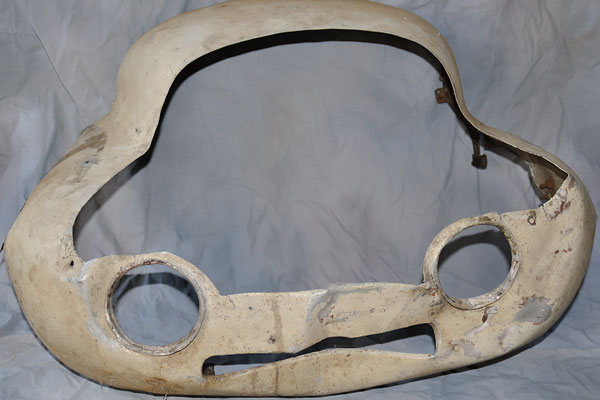
�
At least three of the Lester MGs that raced in North America suffered cooling problems and in each case
�
modified bodywork was part of the solution. Duncan Black cut aggressively into KUR 4's original aluminum
�
nose cose to access more air. A photo of Duncan Black racing with this modified part at Marlboro in an
�
MG Car Club National Race on 30 October 1955 can be viewed on the Straightpipe Magazine website.
�
�
After the 1955 season, Duncan Black sold the Lester MG to James Shoup Miller. �
Duncan Black drove a Lotus in G Modified in early 1956, a Mercedes 300SL on one occasion in August,�
and a Ferrari 4.5L late in the season.�
�
�
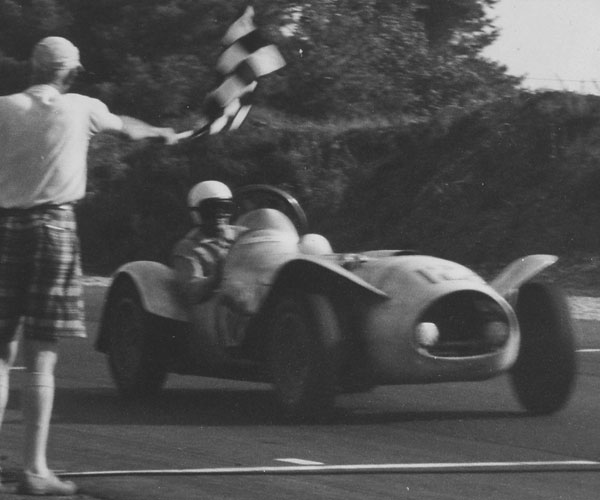
�
This photo and the next one show James Miller racing KUR 4 at Vineland Raceway in New Jersey in 1961.
�
(Photo by Maryel Miller.)
�
James Miller and Lester MG Registration Number KUR 4
��
From 1956 through 1961, KUR 4 was raced by James Miller. It stayed in Miller's possession until�
about 1992. During James Miller's ownership, the original MG TC engine began having major problems�
related to its oversized cylinder sleeves. Miller decided to remove the MG TC motor and instead�
install an MGA engine. At 1500cc, the MGA engine obviously didn't represent a significant change�
in displacement and the car stayed in F Modified.�
�
| Date | Event | Classes Participating | Result | Comments | |
| 8/18/57 | SCCA National at Montgomery AFB | (FM+GM) | 9th of 18 | ||
| 8/17/58 | SCCA National at Montgomery AFB | (FM+GM) | 10th of 14 | ||
| 9/1/58 | SCCA National at Thompson CT | (BM+CM+DM+EM+FM) | 10th of 13 | ||
| 11/16/58 | Washington Regional (preliminary) | (BM+CM+EM+FM+GM) | 6th of 11 | (5th <1500cc Mod.) | |
| 11/16/58 | Washington Regional at Marlboro MD | (BM+EM+FM+GM+BP+CP+DP) | 8th of 17 | (4th <1500cc Mod.) | |
| 9/9/59 | SCCA National at Montgomery AFB | (BM+CM+DM+EM+FM) | 16th of 21 | ||
| 6/5/60 | 6 Hour Enduro at Marlboro MD | (all classes) | 5th of 18 | (co-driver Joseph G. Dodge Jr.) | |
�
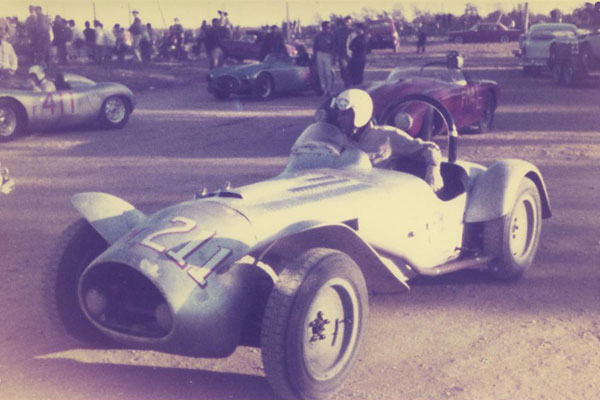
�
James Miller replaced KUR4's crudely-modified original aluminum nose cone with a fiberglass part. Fellow
�
racer Bill Rutan had previously had a custom aluminum nose cone fashioned for his own Lester MG,
�
featuring an enlarged radiator opening. Rutan's aluminum nose cone was used as a model (i.e. a "plug")
�
to make a fiberglass mold and probably two fiberglass replacement nose cones. (Photo by Maryel Miller.)
�
�
So configured, James Miller raced his Lester MG in regional events until late in 1961, when�
it was crashed. The crash damaged the frame badly, but did remarkably little harm to the body. From�
1961 through 1975, the Lester body set in the rafters of James Miller's barn in Orangeburg, New York.�
Miller had kept all the car's other components, except the original frame.�
�
Then, James Miller decided to put KUR 4 back together on a replica frame. One particular vintage�
car race - a "Double 3 Hour" endurance race at Lime Rock Park scheduled for 1977 - was selected�
as both goal and deadline. Miller's friends Doug Schirripa, Joe Dodge and Ernest Cassis pitched�
in and helped with the restoration project. Charles DeLisle contributed an MG TC engine, complete�
with Lucas-Laystall aluminum head; this was a very big help since the original MGA motor wasn't�
ready in time. Unfortunately, the MG TC engine dropped a valve during the race weekend, and KUR 4�
went back into storage for about fifteen more years.�
�
Please support the sponsoring companies who make www.BritishRaceCar.com possible, including:
� �
 �
�
�
�
Vintage Racing a Lester MG
� �
Doug Schirripa and Tom McCormack have been buddies since college. They own and race several cars�
together, even while Doug lives in Orange County California and Tom lives in Troy, New York. In�
the early 1990s, when Jim Miler decided to retire and relocate, he offered Doug Schirripa the�
Lester MG. Doug returned to New York from his home in California to retrieve the car. Doug�
didn't make any immediately plans to race KUR 4 though, until he learned that a vintage event was�
being planned for the nearby Tustin Marine Air Base. It was scheduled for the summer of 1996.�
Again, a specific race provided motivation for pressing the car back into service. Although the�
1996 outing wasn't successful - the Lester MG scored a DNF - Doug was motivated to meticulously�
race-prep KUR 4 and to start actively vintage racing it.�
�
�
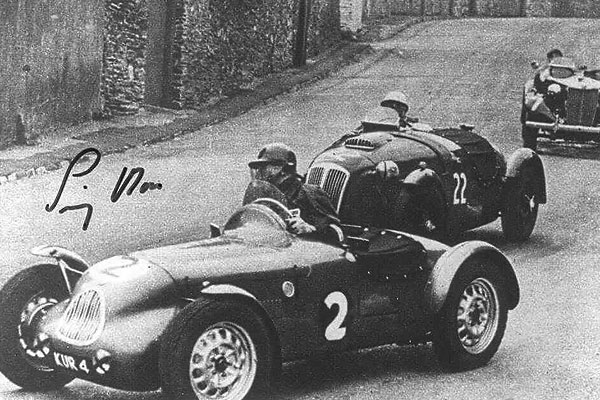
�
Jim Mayers (#2 Lester MG, KUR 4) appears to lead Stirling Moss (#22 Frazer-Nash LeMans Replica) and
�
M.J. Pople (#7 MG TD) in the British Empire Trophy race on the Isle of Man, 14 June 1951. Lest the
�
photo be a misconstrued: Mayers was obliged to retire from the race due to engine trouble and, with his
�
powerful 2-liter Bristol powered racecar, Moss managed to lap Pople's 1.5-liter MG three times in the
�
course of the 135-mile race. (Note: Stirling Moss autographed this photo for Doug Schirripa in 1998.)
�
�
In 1997, Tom visited California to drive KUR 4 in the 1997 Tustin Thunder race and in the 1997 LA�
Times Grand Prix through the streets of downtown Los Angeles. The LA Times Grand Prix seemed to offer�
an opportunity for KUR 4 to race with a Frazer-Nash LeMans Replica it had first competed with�
back in June 1951. Racing great Stirling Moss, who had piloted the Frazer-Nash to victory on that�
occasion was on hand to share his memories of the original race, and of the Lester MGs too. In an�
interesting twist, we now know Moss actually raced his LeMans Replica against a replica of KUR 4�
back in 1951.³�
�
In 1998, Tom drove KUR 4 at Button Willow's British Extravaganza. Unfortunately, throughout this�
period KUR 4 was rarely recognized by West Coast fans. Remarkably, contemporary fans often mistook�
the Lester MG for Ken Miles' famous Flying Shingle. The history of Harry Lester, of Duncan Black,�
and of KUR 4 specifically weren't really appreciated in California. �
�
In 1998, Doug decided KUR 4 should return home to the East Coast. Driving it, Doug placed third�
at the Pittsburgh Vintage Grand Prix and Tom qualified for pole position in the 1998 Vintage Fall�
Festival at Lime Rock. On the following weekend the team took KUR 4 to Watkins Glen for an�
MG Vintage Racers focus event. However, when Doug took KUR 4 out for practice he realized it was�
going to be a very long day. With the car's 5.125:1 rear end ratio, he ran out of revs before�
leaving pit lane. During 1999, KUR 4 was entered in two events: the Pittsburgh Grand Prix (DNF)�
and the Vintage Fall Festival (first in class in the pouring rain).�
�
In 2001, Tom drove KUR 4 in the Mt. Equinox hillclimb. He also loaned the car to former Lester MG�
racer Bill Rutan for a run up that famous hill. In the paddock at Mt. Equinox, Tom and Doug were�
visited by Don Millians, one of the early owners of KUR 4 who lived nearby at the time. It was the�
first time Millians had seen the car since he sold it to Duncan Black in the early 1950s. KUR 4�
put smiles on a lot of faces that day.�
�
Every autumn since 2001, KUR 4 has been entered in Historic Festivals at Lime Rock Park in�
Connecticut. Depending on the year, it's been grouped with pre-war Grand Prix cars or with early�
MG racecars. Particularly at Lime Rock, every year fans visit this distinctive car in the paddock�
and tell stories of having seen Duncan drive it back in the day. KUR 4 is a true vintage race car,�
not a vintage car that has more recently been converted to racing. It has an interesting history�
and it's actively campaigned as it appeared toward the end of its original racing career.�
�
 �
�
�
�
Features and Specifications
�| Engine: | �MGA 1.5L engine.�
~12:1 static compression ratio.�
HRG crossflow aluminum cylinder head.�
HRG intake manifolds.�
Dual S.U. H6 (1 3/4" bore) carburetors.�
Lucas distributor with Pertronix Ignitor breakerless ignition module.�
Pertronix Flame-Thrower (0.6 ohm) ignition coil.�
MSD spark plug wires.�
Mocal 13-row oil cooler.�
Fram spin-on oil filter.�
| �
| Cooling: | �custom copper and brass radiator by Tom's Radiator in Orange California. | �
| Exhaust: | �custom three-into-one header. | �
| Transmission: | �MG TC 4-speed gearbox.�
Custom aluminum engine plate and welded steel adapter ring (circa ~1959) to suit the MGA engine. | �
| Rear Axle: | �MG Y-type rear axle. (Similar to MG TC, but slightly wider and with 5-lug hubs.) 5.125:1 ring and pinion. | �
| Front Susp.: | �MG TD front suspension and steering rack.�
Armstrong lever shock absorbers. | �
| Rear Susp.: | �7-leaf leafsprings.�
Monroe Magnum telescoping shock absorbers (part# 36047). | �
| Brakes: | �Alfin finned drum brakes, front and rear. | �
| Wheels/Tires: | �vintage Halibrand "Smoothie" magnesium racing wheels (15"x4.5").�
Dunlop Racing - CR65 Mark II (5.00L-15 front and 5.50L-15rear). | �
| Electrical: | �Odyssey PC680 dry cell battery.�
Lucas starter motor. | �
| Instruments: | �(left to right)�
Smiths dual oil pressure (0-100psi) and water temperature gauge (90-230F),�
Jaeger oil pressure gauge (0-160psi),�
Smiths Chromometric tachometer (500-8000rpm),�
ammeter (+/-20 amps).�
| �
| Fuel System: | �custom Fuel Safe 8-gallon fuel cell.�
Purolater "cube" solid state electric fuel pump. | �
| Safety Eqmt: | �G-Force Pro Series five point cam-lock safety harness.�
Phoenix fire suppression system. | �
| Weight: | �~1300#. | �
�
Please support the sponsoring companies who make www.BritishRaceCar.com possible, including:
� �
 �
�
�
�
Engine Installation
��
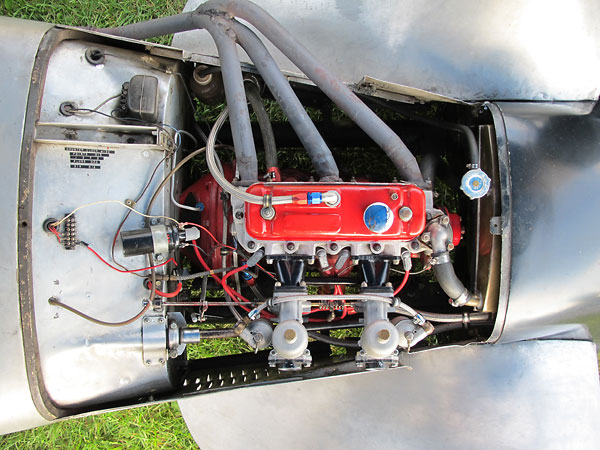
�
This is the same MGA 1500cc motor that James Miller originally installed in the late 1950s.
�
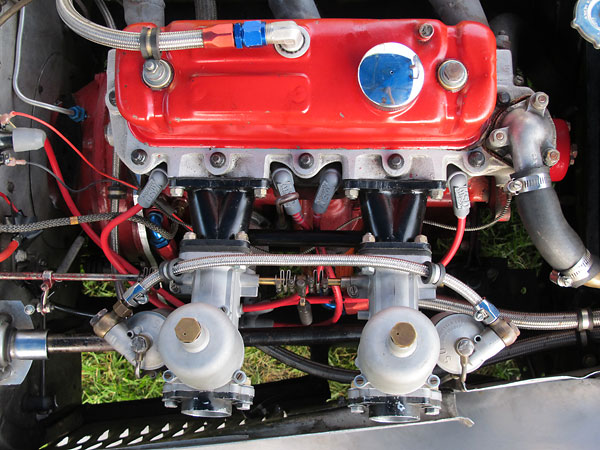
�
HRG crossflow aluminum cylinder head, HRG intake manifolds, and dual S.U. H6 (1.75" bore) carbs.
�
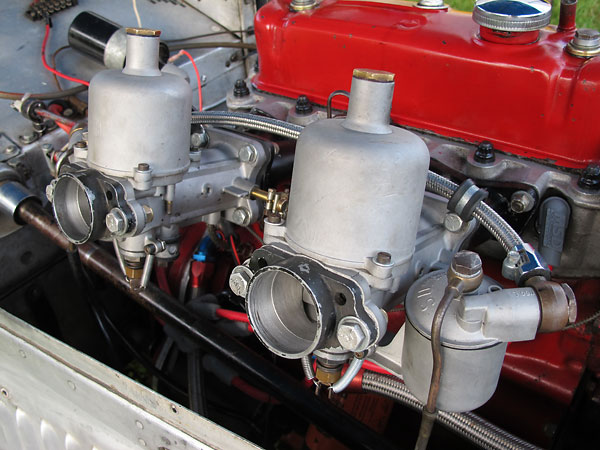
�
McCormack & Schirripa have tried velocity stacks in the past. In 2011 they used short carb extensions.
�
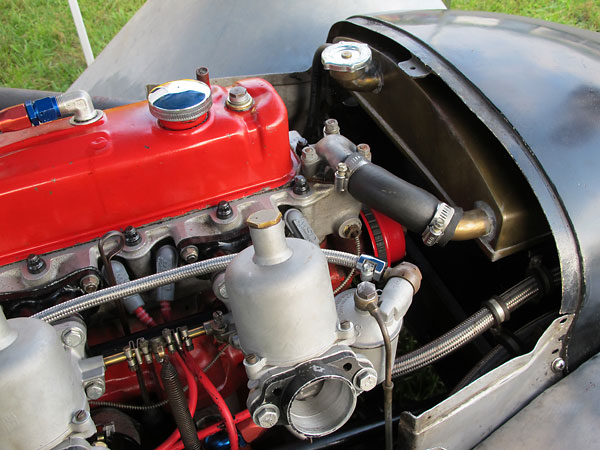
�
Custom copper and brass radiator by Tom's Radiator of Orange California. The previous radiator
�
featured a honeycomb core, and was part of an unpressurized cooling system. The new radiator
�
and pressurized system provide much more effective engine cooling.
�
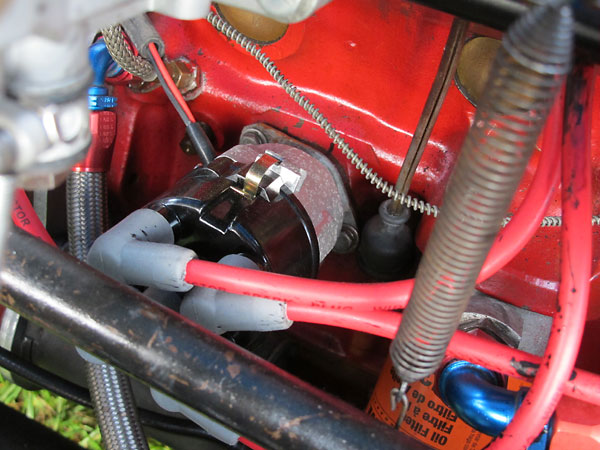
�
Lucas distributor with Pertronix Ignitor breakerless ignition module. MSD spark plug wires.
�
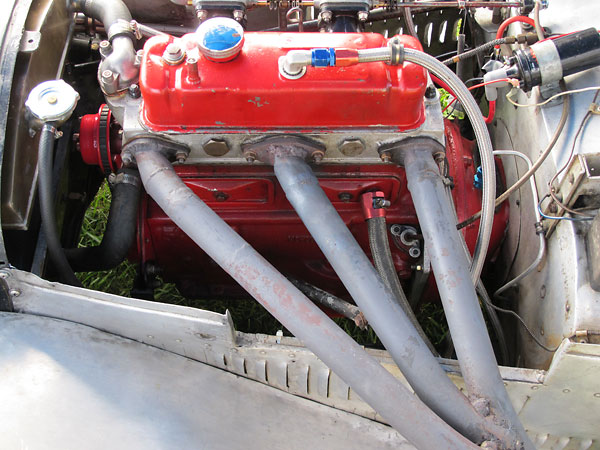
�
This exhaust header was built when HUR 4 was restored in the mid-1970s, but it's similar to what
�
James Miller installed when he fitted the MGA engine and HRG cylinder head in the late 1950s.
�
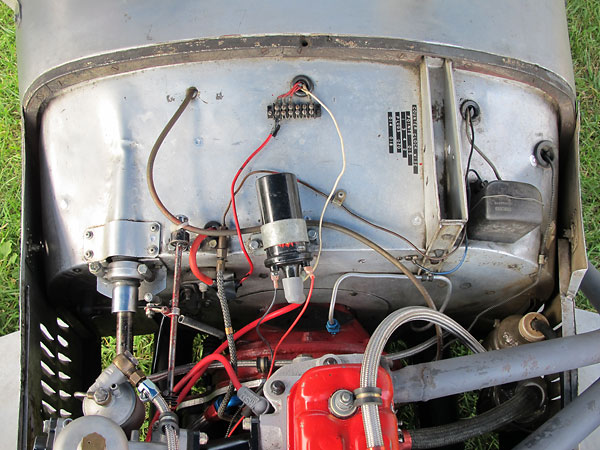
�
Labels on the cowl: "Counter Clock Wise" (distributor rotation) - "Points 015" (0.015" gap when open)
�
"1 3 4 2" (firing order) - "Plugs 020" (0.020" electrode gap. Note: 0.025" was stock.)
�
"014 018" (0.014" intake and 0.018" exhaust rocker-to-valve clearances.)
�
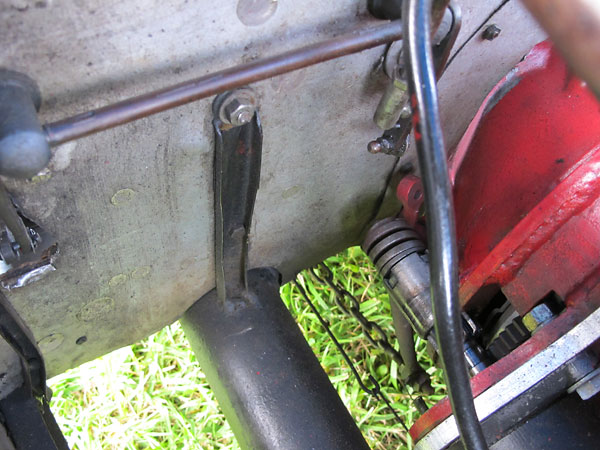
�
In this view you can see one of the body mounts, details of the throttle and clutch linkage, the
�
Lucas starter motor bendix, and most importantly the custom aluminum engine plate and the welded
�
steel adapter ring that mate a later (MGA) engine to an earlier (MG TC) 4-speed gearbox.
�
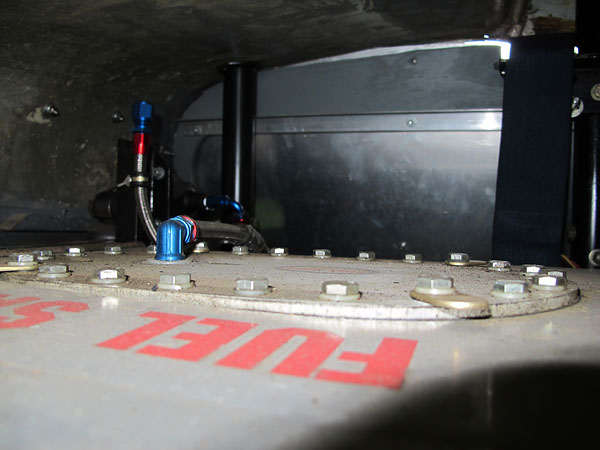
�
Custom Fuel Safe eight gallon fuel cell.
�
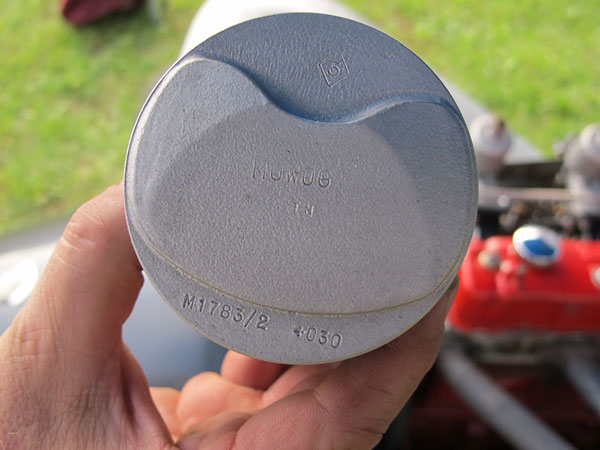
�
MOWOG piston marked 3 and M1783/2 +030. (In other words, 0.030" oversize in diameter.)
�
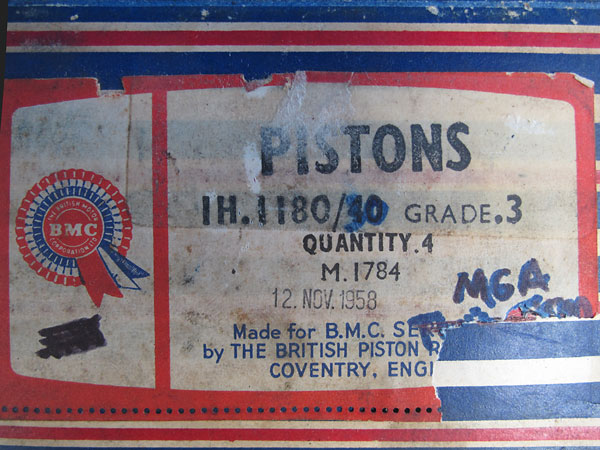
�
BMC - The British Motor Corporation
�
Pistons - IH.1180/4030 - Grade.3 - Quantity.4 - M.1784 - 12.Nov.1958
�
Made for B.M.C. Service Use by The British Piston Ring Company, Coventry, England
�
�
IMPORTANT ANNOUNCEMENT
�
BritishRaceCar.com will have to cut back plans for continued growth if we can't find more financial support.
�
If you like what you've found here, and you want to see more, please click here and follow the instructions.
�
Readers like you keep BritishRaceCar.com online and growing through voluntary financial contributions.
�
Front Suspension
��
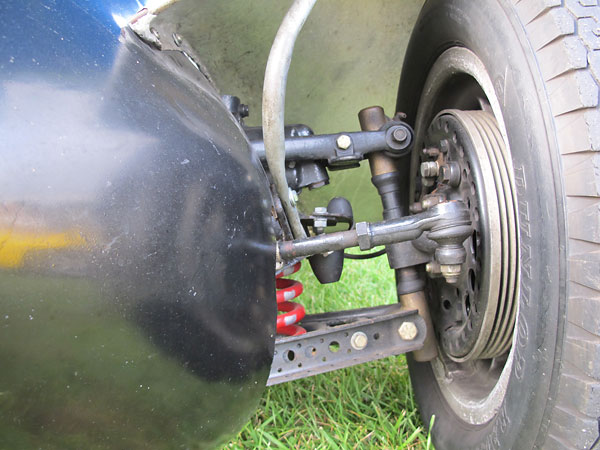
�
From the MG TD parts bin: independent front suspension with unequal length A-arms,
�
coil springs, knee-action hydraulic shocks, and rack and pinion steering.
�
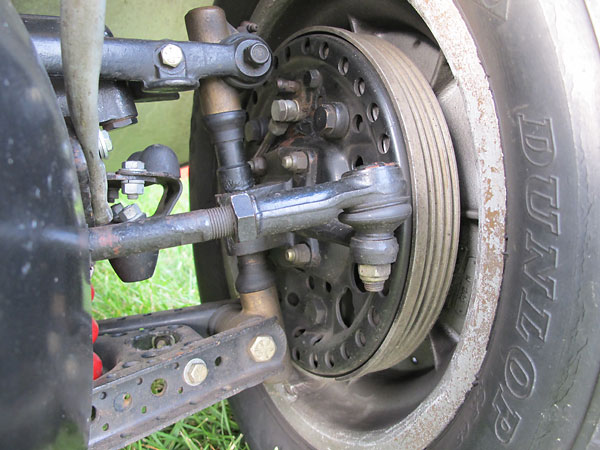
�
Alfin (aluminum finned) brake drums have been on this car since before it came to America.
�
Tom says: "It actually has pretty good brakes! Doesn't need much, since it only weighs 1300 pounds."
�
�
Rear Suspension
��
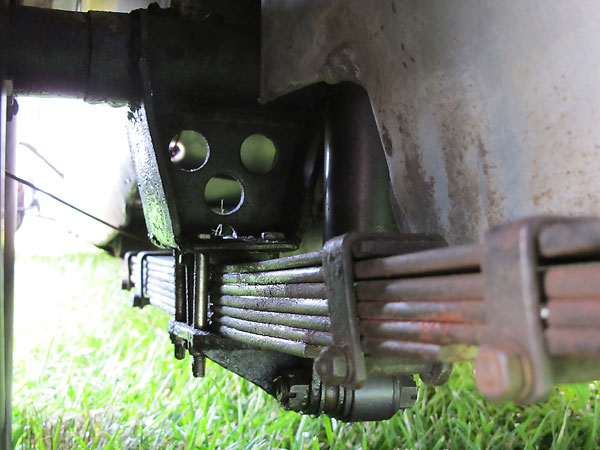
�
On an ordinary MG TC or TD, the rear axle sits immediately above the leafsprings. On a typical
�
MG TC or TD vintage racecar, you might find one-inch aluminum lowering blocks between the axles
�
and springs. Compare that to what we see here: the Lester MG rides three to four inches lower!
�
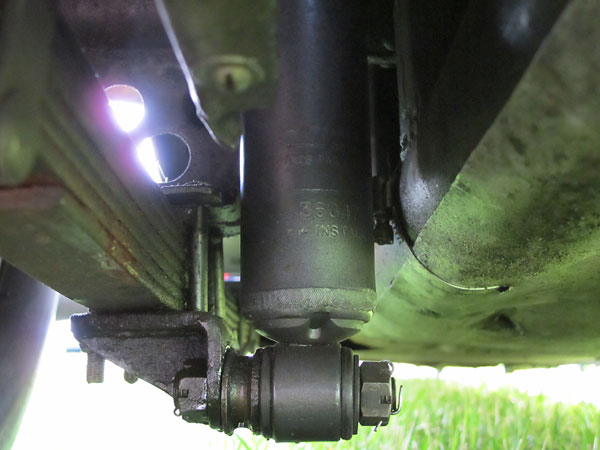
�
Monroe Magnum telescoping shock absorbers. This particular shock absorber (part# 36047)
�
is popular with MGB enthusiasts as a bolt-on replacement for original MGB lever shocks.
�
Harry Lester is known to have fitted Monroe telescoping shocks on some of the Lester MGs.
�
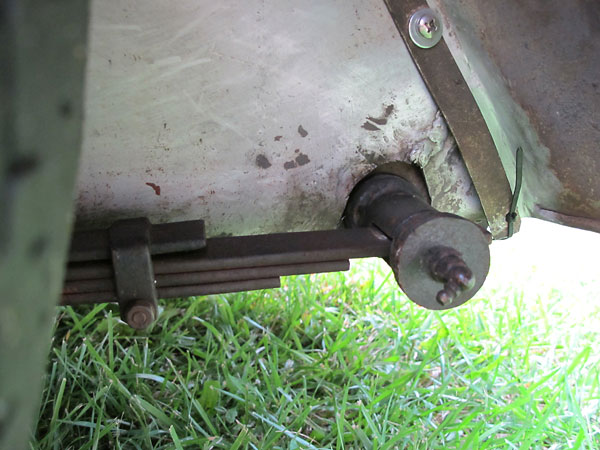
�
The rear ends of the leafsprings float in sliding trunnions, like pre-war MG cars including the TB.
�
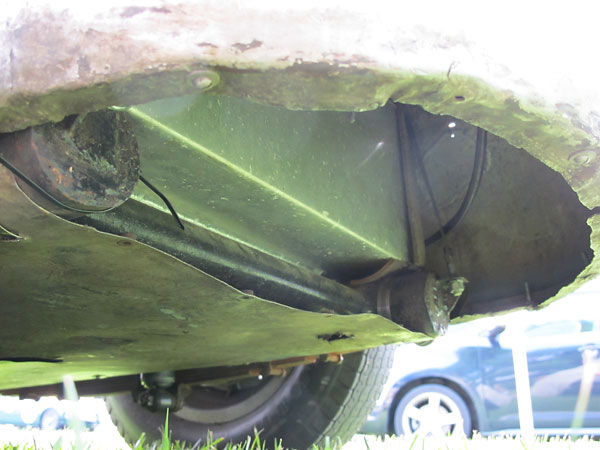
�
Lester fabricated his frames from round tubing.
�
�
Interior
� �
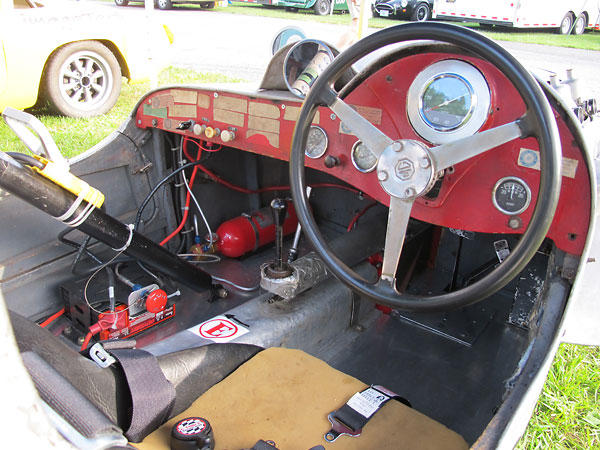
�
Evidently to comply with arcane rules, the cockpit has a hinged door. It's on the passenger's side.
�
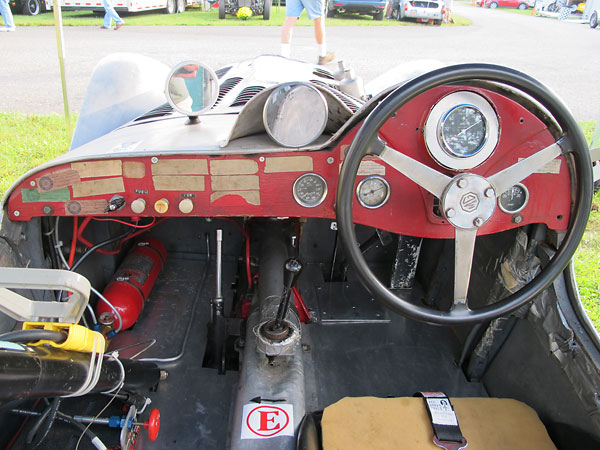
�
Lester MG KUR 4's wooden dashboard, with fourteen faded SCCA tech-inspection decals still attached.
�
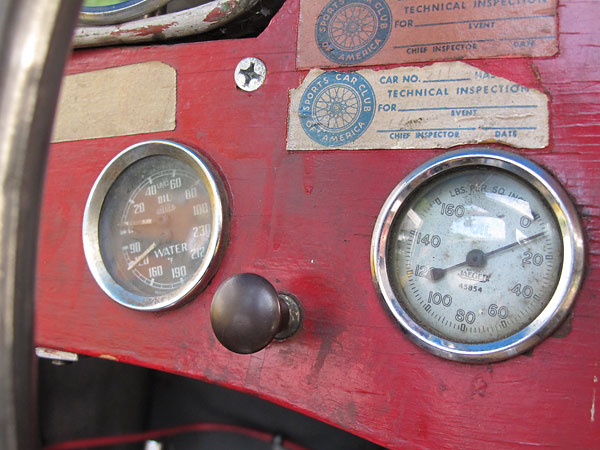
�
Smiths dual oil pressure / water temperature gauge and Jaeger oil pressure gauge.
�
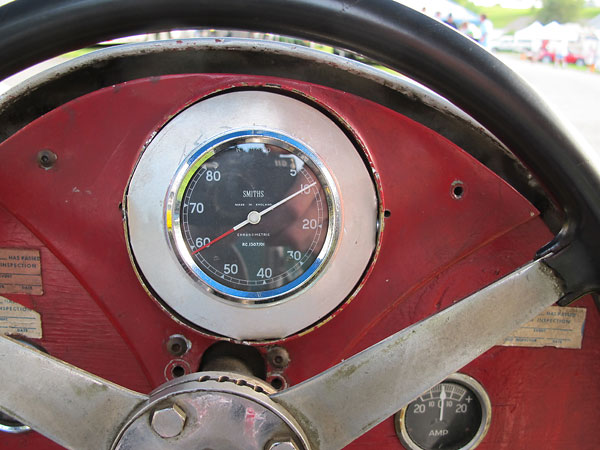
�
Smiths Chromometric tachometer (500-8000rpm).
�
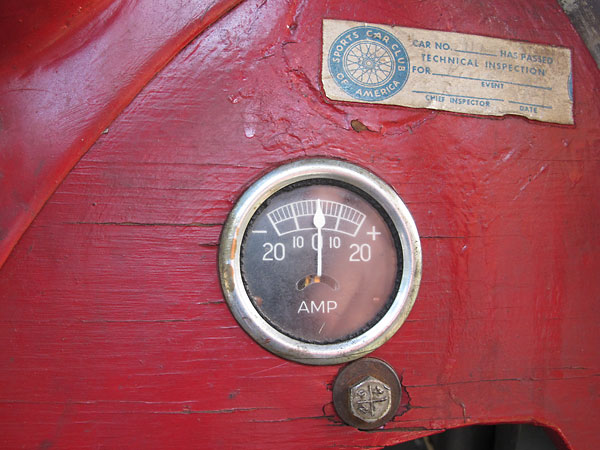
�
Vintage ammeter (+/-20 amps).
�
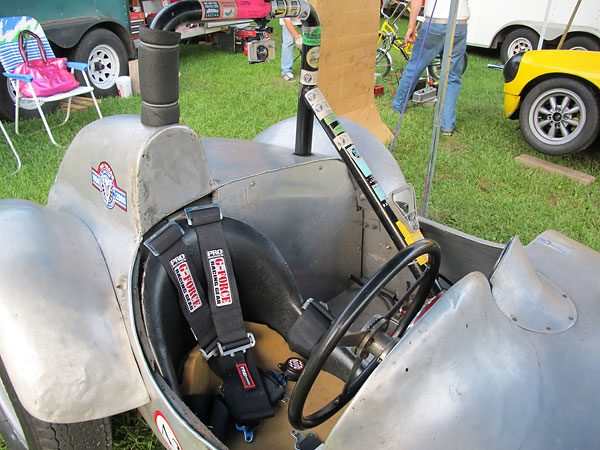
�
Mid-1970s vintage roll hoop to comply with then-current vintage racing safety requirements.
�
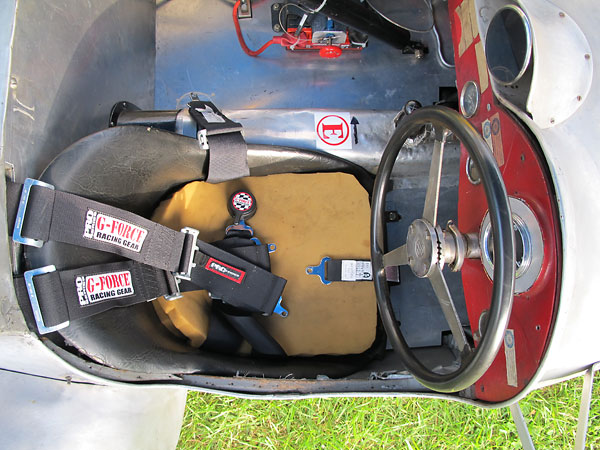
�
G-Force Pro Series five point cam-lock safety harness.
�
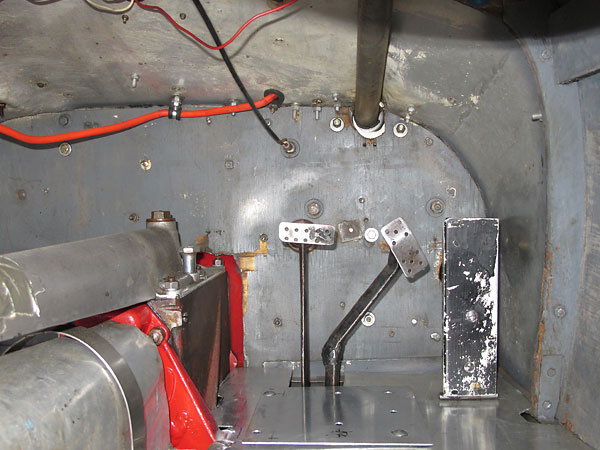
�
There's not much dead weight to be found here!
�
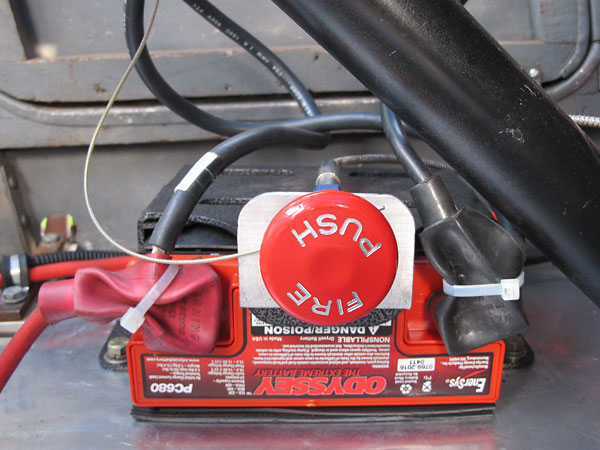
�
Odyssey PC680 dry cell battery.
�
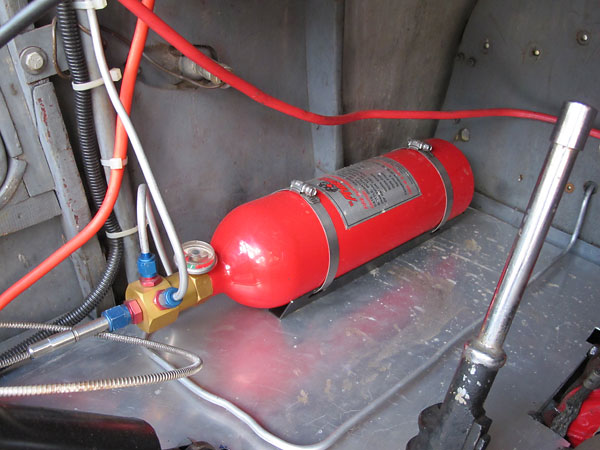
�
Phoenix fire suppression system.
�
�
Exterior
��
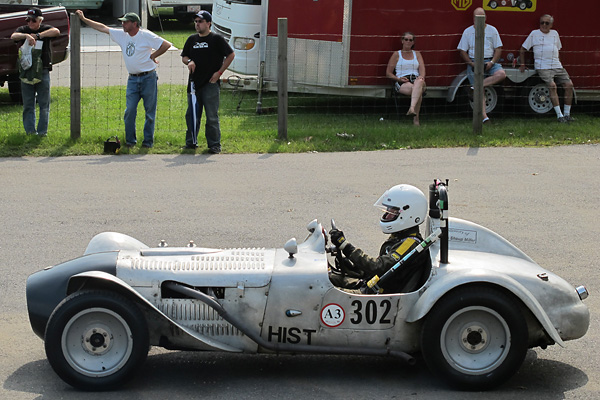
�
At the 2011 Lime Rock Historic Festival, Tom McCormack drove the Lester MG to a tenth place of 35
�
entries in Saturday's All-MG Feature Race. Then, on Monday he finished eighth of 32 cars overall
�
in the Group 1 race (nominally for "Pre-War Sports and Competition Cars") circling the tight,
�
hilly, and difficult 1.51 mile track at an average speed on 73.336mph.
�
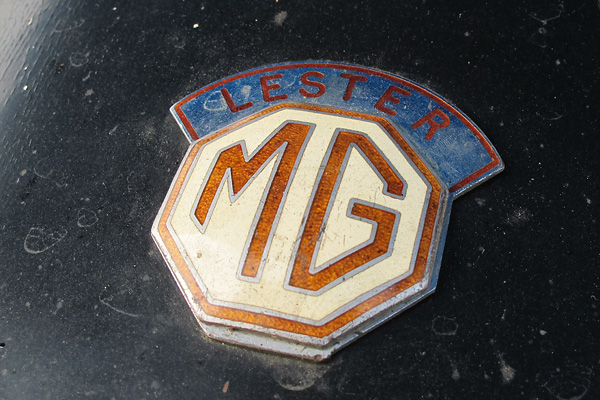
�
An authentic early-style Lester badge sits like a crown over the familiar octagonal MG emblem.
�
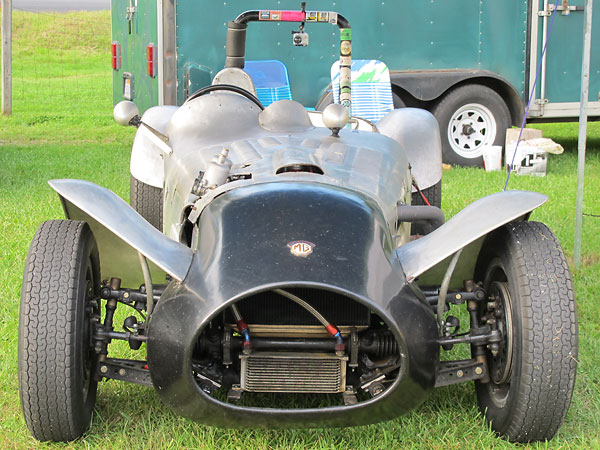
�
This is the very same fiberglass nose cone that Larry Miller raced with in the late 1950s / early 1960s.
�
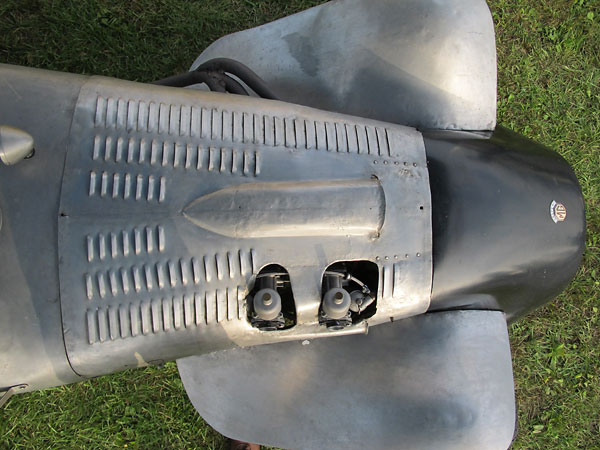
�
One winter in the late 1950s, James Miller spent a lot of time scraping the paint off this car.
�
He gathered all the paint chips and weighed them: 9 pounds! He decided not to repaint it.
�
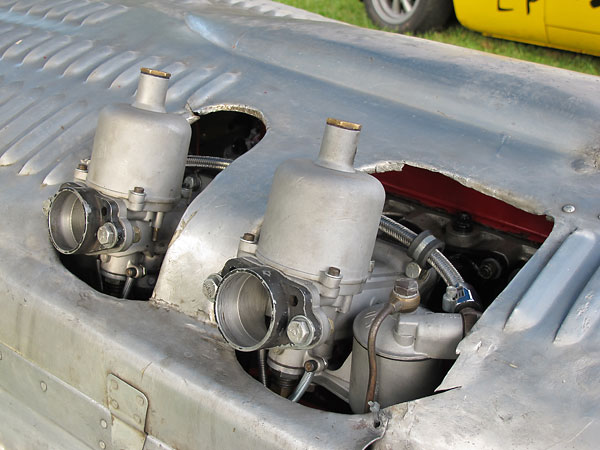
�
This Lester MG originally had a non-crossflow cylinder head, and its S.U. carbs were mounted
�
lower and closer to the engine. In those days, the carburetors didn't poke through the bonnet.
�
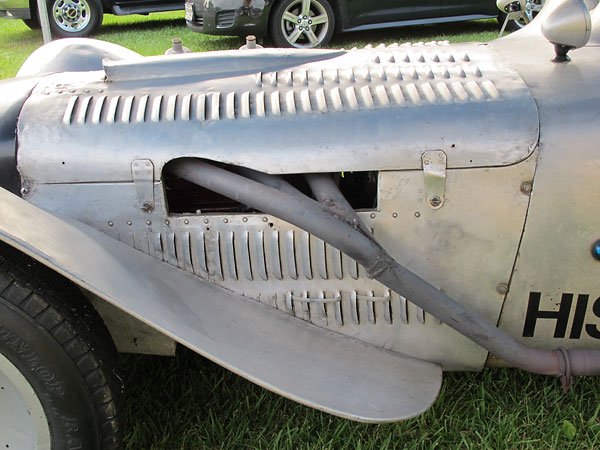
�
Early in KUR 4's racing career, before the HRG crossflow cylinder head was installed,
�
the exhaust routed downward instead of through the side of the engine compartment.
�
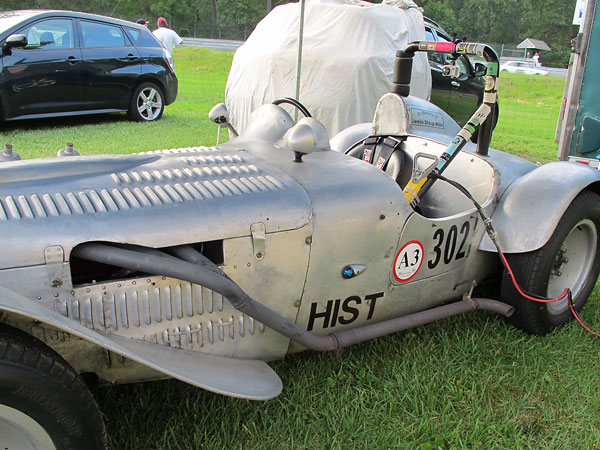
�
From the engine rearward, the exhaust pipe mounted on the driver's side of the car.
�
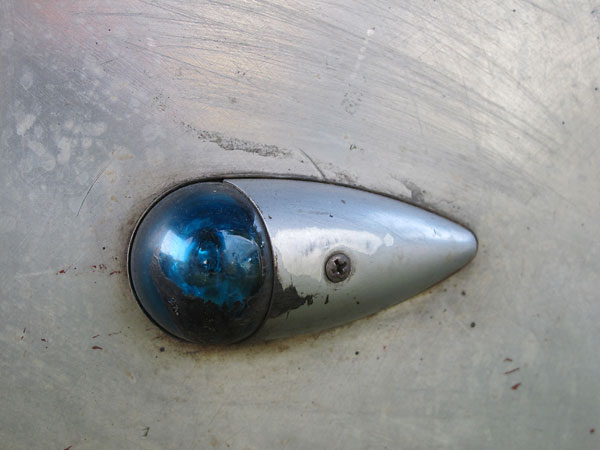
�
This blue ship's light was positioned to illuminate the car's racing number. It was installed specifically
�
for racing at Marlboro Maryland, where the relative placement of the Timing & Scoring station made
�
identifying passing cars particularly difficult.
�
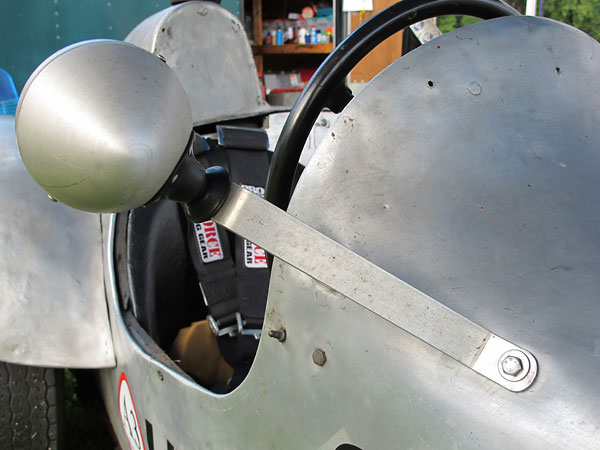
�
GT Classic mirror.
�
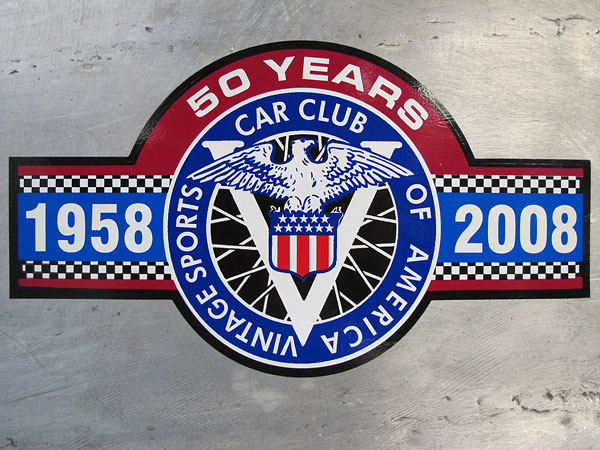
�
Vintage Sports Car Club of America - 50 years - 1958-2008
�
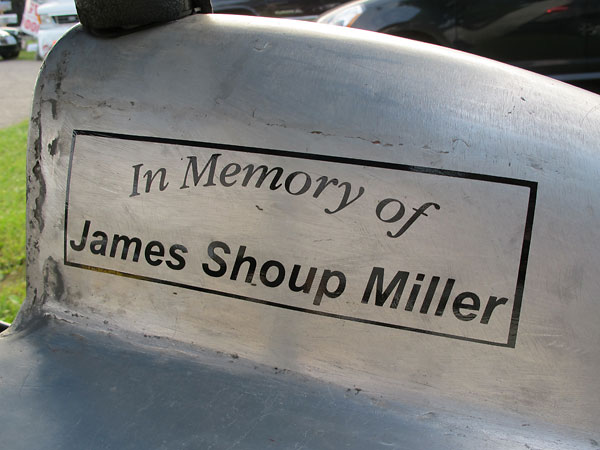
�
In Memory of James Shoup Miller
�
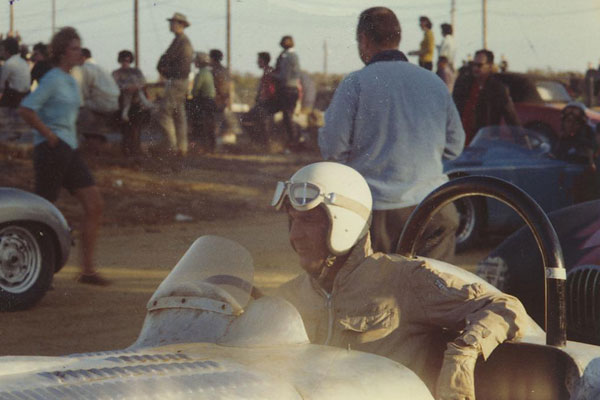
�
James Shoup Miller waits patiently in the pre-grid at Vineland, NJ in 1961.(Photo by Maryel Miller.)
�
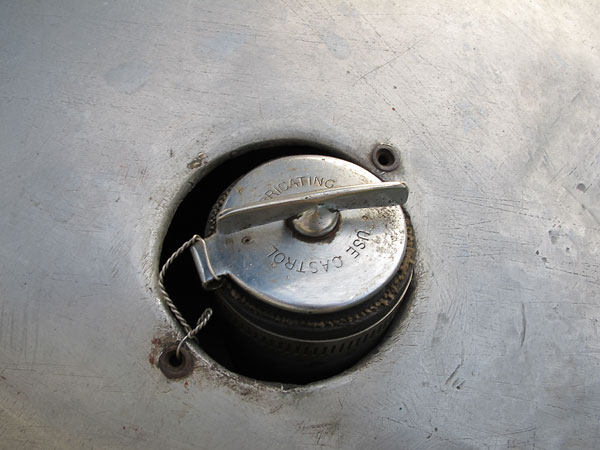
�
Vintage fuel filler cap. (It's no longer in actual use.)
�
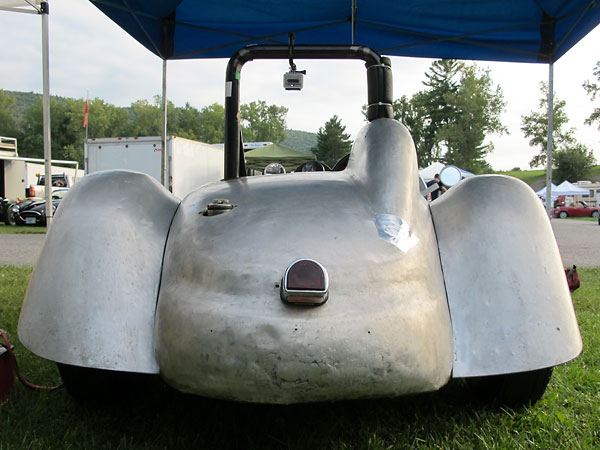
�
1949-1954: narrow cycle-style fenders. 1955-1959: the wide fenders that you see here.
�
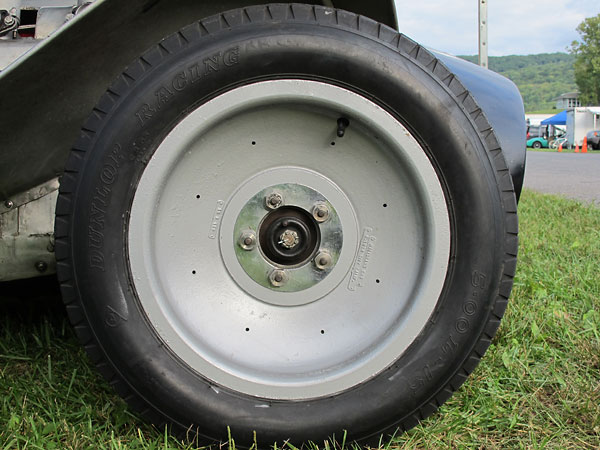
�
Dunlop Racing CR65 MkII vintage racing tires (5.00L-15 front and 5.50L-15 rear.)
�
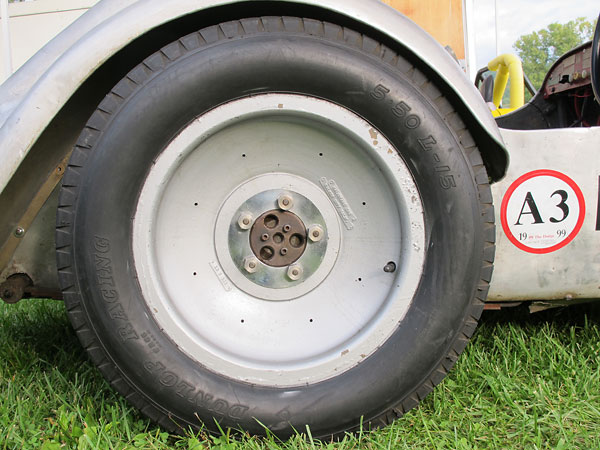
�
This Lester MG was equipped with stamped steel Morris Eight wheels when it was imported to U.S.A.
�
They were pretty, but weak and not particularly light. Duncan Black bought two sets of magnesium
�
Halibrand sprint car wheels (known as Smoothies), and that's what the car has raced on ever since.
�
Note: Halibrand drilled eight small holes in each wheel for attachment of tire balancing weights.
�
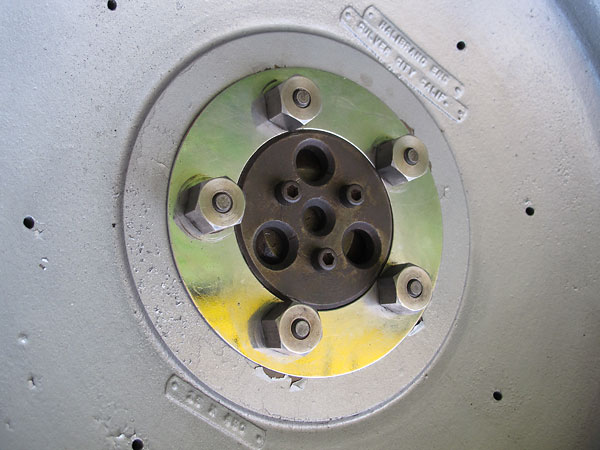
�
Halibrand Engineering - Culver City, California - 15x450
�
| Notes: | |||||||
| (1) | �
Harry Lester's M-series body styling was not well received. At least two of the original M-series�
chassis were completed or updated during the 1950s with more attractive fiberglass kit-car bodies�
from Ashley Laminates Ltd. This was certainly true of 5 EME, although even more recently (~2005)�
5 EME has been updated with a custom aluminum body. Enthusiasts can be excused for not knowing�
what an authentic Lester M-series would look like. In North America, we've often seen one particular�
curvacious, aluminum-bodied vintage MG special misleadingly badged and presented as a Lester MG.�
This is a pity because the car in question has an interesting history of its own, waiting to be told. � | ||||||
| (2) | �
The 1951 Watkins Glen program shows that David C. Viall of Alexandria Virginia pre-registered an MG Special�
and was assigned racing number 19. The program also shows a listing for Perry Boswell Jr. of Upper Marlboro,�
Maryland with a "Lester MG". Boswell was assigned racing number 36. Alexandria and Upper Marlboro are both�
suburbs of Washington DC; about twenty miles apart. Crystal clear photos from the race make it very easy�
to identify David Viall's #19 car as a Lester MG. On the other hand, Perry Boswell is among fourteen�
registrants who didn't participate in the actual race. It seems highly likely - if not absolutely certain -�
that David Viall ended up racing the car that Perry Boswell initially intended to drive. Furthermore,�
except for its racing number, car 19 looks identical to photos of the Lester MG that Donald E. Millians�
entered and recruited Duncan Black to drive at Watkins Glen in 1953. Millians' home in Baltimore Maryland�
is about 38 miles due north of Upper Marlboro. �
� Jim Mayers' "NNK 526" soon followed Harry Lester's KUR 4 to America. NNK 526 was purchased and very� actively raced by William B. Lloyd of Green's Farm, Connecticut. (Briggs Cunningham lived in the same town.)� From 1953 race reports, it seems Bill Lloyd recruited other drivers to drive the Lester, including� specifically C.G. Bennett and Leroy Thorpe. For the 1953 season, the original MG powerplant was replaced� with an Offenhauser engine. NNK 526 was driven by William Eager during the 1954 and 1955 seasons, and� by Floyd Stone during 1958. NNK 526 is currently receiving a very authentic restoration to its 1951� configuration by Lester MG specialist Roy Jacobson.� � Harry Lester installed an enlarged (1466cc) engine and a "T51" style aluminum body on his MG TA� (serial TA2460, registration KJH 114). This third Lester was imported to the United States by Don F.� Marsh to be raced in SCCA's F Modified class during 1954. Marsh sold KJH 114 to Chuck Dietrich who� evidently fitted a 1250cc engine to race in SCCA's G Modified class during 1955. Dietrich sold� KJH 114 to the Funny Face Auto Racing Team. Under their ownership, drivers Ted Jayne and Charles� Ellmers made appearances with it in 1956. They evidently upgraded it to an MGA engine or possibly� re-installed the old Lester-modified engine, to race in SCCA's F Modified class in 1957. Charles� Ellmers apparently retained the car after the team dissolved, because he is recorded as having driven� it at one race in 1962. KJH 114 is currently vintage raced in North America by Marvin Primack.� � Records aren't quite so clear about the Lester MG racecar or racecars entered by other drivers� in North America during the 1950s. Bill Rutan entered an F modified class Lester MG in SCCA events� during 1954, and on at least one occasion in 1957. R.D. Ryder entered an F Modified Lester MG in� SCCA races during 1955. (Ryder entered the fourth of four Lesters that met up at Cumberland� Maryland that year.) The registration list for the 1957 Cumberland race weekend shows John Norwood� as having entered a "Lester R" (Riley?) in the F Modified class. That may or may not be an error;� John Norwood entered a Bristol powered Lister in multiple races during 1957, but that car's� larger engine put it in the E Modified class.� � Richard (Dick) Duncan in California posted on the Autosport "Nostalgia Forum" message board in� August 2010: "I own what we think may be the only M-11 chassis with Climax power. It came to� California with an Ashley body in 1957. I also own an M-15 chassis and the original Lester alloy� coupe body which was the prototype for the M series Monkey Stable cars. This car was owned by and� raced at Goodwood in 1956 driven by Ted Pool." (Ted Pool's Goodwood registration shows that he drove� HJB 790. The same car had been driven by Harry Lester at several events during 1953.)� � | ||||||
| (3) | �
Although the car driven by Jim Mayers wore the registration number KUR 4 throughout the 1951 British�
Empire Trophy race weekend, it was actually a different car. The real KUR 4 as featured throughout our�
article had already been sold, shipped to the United States, and raced at Bridgehampton by the time�
the British Empire Trophy was contested. Per historian and Lester MG owner Stewart Penfound, Jim Mayers�
actually drove a newly built Lester MG that weekend. Mayers' car would be properly registered as NNK 526�
about one month later. � | ||||||
�
We'd like to acknowledge two particularly helpful online resources which aided the development of this article:�
(1) Cliff Reuter's collection of scanned vintage SCCA programs and results information at etceterini.com,�
and (2) the driver database at racingsportscars.com. �
�
| �
� 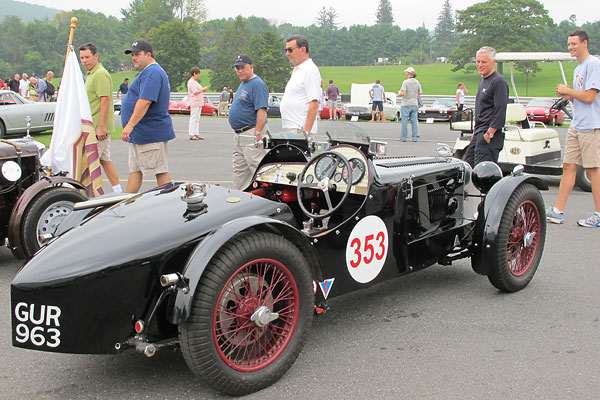 � Harry Lester's MG P-type (GUR 963), as photographed by Curtis Jacobson for BritishRacecar.com � Did you enjoy this article? We currently have eighty more in process, featuring about 6000 new photos. � It's research that slows things down. Please help by making a voluntary contribution to our library fund. � Your donation will help us complete and publish more articles, sooner! � � |
�
Five of the black-and-white photos shown here are from Doug Schirripa's personal photo collection, but the�
original photographers are unknown. We believe their use in this article complies with "Fair Use"�
guidelines as established by the U.S. Supreme Court and others. The one color photo of KUR 4's original�
(but modified) aluminum nosecone is by Doug Schirripa, and is used by exclusive permission. The four photos�
that show KUR4 with owner/driver Larry Miller were all taken by Larry Miller's first wife, Maryel Miller.�
Maryel Miller's photos are from the collection of Jim Blakeney, and are used here by his permission.�
All other color photos shown here are from September 2011 when we viewed the car at Lime Rock Park in Connecticut.�
Photos by Curtis Jacobson for BritishRaceCar.com, copyright 2012. All rights reserved.�
�
| If you liked this article, you'll probably also enjoy these: | �|||||
 | �
Dan Leonard '49 MG TC (Special) | �
 | �
Paul Bova '59 Turner Mk1 | �
 | �
Joe Dockman '60 Daimler SP250 | �
| You're invited to discuss anything you've seen here on The British Racecar Motorsports Forum! | �|||||
�
Notice: all the articles and almost all the photos on BritishRacecar.com are by Curtis Jacobson.
�
(Photos that aren't by Curtis are explicitly credited.) Reproduction without prior written permission is prohibited.
�
Contact us to purchase images or reproduction permission. Higher resolution images are optionally available.
�
